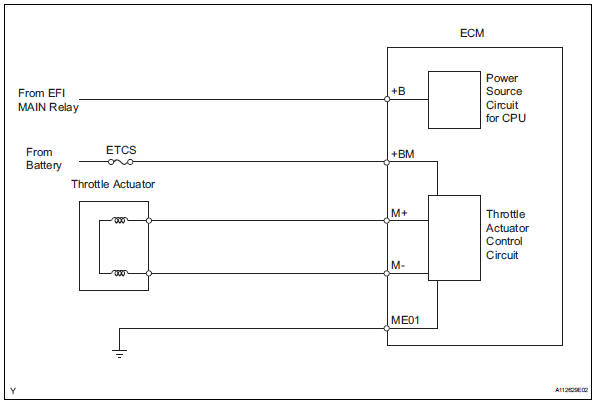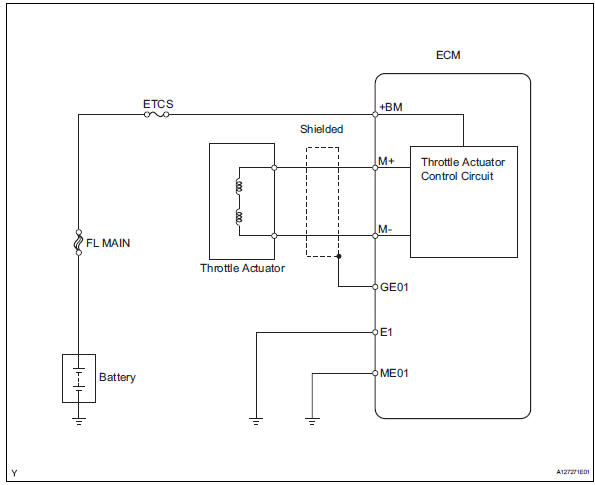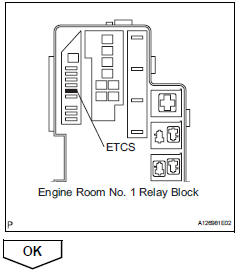Toyota RAV4 (XA40) 2013-2018 Service Manual: Throttle actuator control motor current range / performance

Description
The etcs (electronic throttle control system) has a dedicated power supply circuit. The voltage (+bm) is monitored and when it is low (less than 4 v), the ecm determines that there is a malfunction in the etcs and cuts off the current to the throttle actuator.
When the voltage becomes unstable, the etcs itself becomes unstable. For this reason, when the voltage is low, the current to the throttle actuator is cut. If repairs are made and the system returns to normal, turn the ignition switch off. The ecm then allows the current to flow to the throttle actuator so that it can be restarted.
Hint:
The etcs does not use a throttle cable.


Monitor description
The ecm monitors the battery supply voltage applied to the throttle actuator.
When the power supply voltage (+bm) drops below 4 v for 0.8 Seconds or more, the ecm interprets this as an open in the power supply circuit (+bm). The ecm illuminates the mil and sets the dtc.
If the malfunction is not repaired successfully, the dtc is set 5 seconds after the engine is next started.
Monitor strategy

Typical enabling conditions

Typical malfunction thresholds
![]()
Component operating range
![]()
Fail-safe
When this dtc, or other dtcs relating to etcs (electronic throttle control system) malfunctions, are set, the ecm enters fail-safe mode. During fail-safe mode, the ecm cuts the current to the throttle actuator off, and the throttle valve is returned to a 6° throttle angle by the return spring. The ecm then adjusts the engine output by controlling the fuel injection (intermittent fuel-cut) and ignition timing, in accordance with the accelerator pedal opening angle, to allow the vehicle to continue at a minimal speed.
If the accelerator pedal is depressed firmly and gently, the vehicle can be driven slowly.
Fail-safe mode continues until a pass condition is detected, and the ignition switch is then turned off.
Wiring diagram

Inspection procedure
Hint:
Read freeze frame data using the intelligent tester. Freeze frame data records the engine condition when malfunctions are detected. When troubleshooting, freeze frame data can help determine if the vehicle was moving or stationary, if the engine was warmed up or not, if the air-fuel ratio was lean or rich, and other data from the time the malfunction occurred.
- Read value using intelligent tester (+bm voltage)
- Connect the intelligent tester to the dlc3.
- Turn the ignition switch on.
- Turn the tester on.
- Select the following menu items: diagnosis / enhanced obd ii / data list / +bm voltage.
- Read the value displayed on the tester.
Standard voltage: 9 to 14 v


- Check fuse (etcs fuse)
- Remove the etcs fuse from the engine room no. 1 Relay block.
- Measure the etcs fuse resistance.
Standard resistance:
below 
- Reinstall the etcs fuse.


- Check harness and connector (ecm - etcs fuse, etcs fuse - battery)
- Check the harness and connector between the etcs fuse and ecm.
- Remove the etcs fuse from the engine room no. 1 Relay block.
- Disconnect the a9 ecm connector.
- Measure the resistance.
Standard resistance (check for open)

Standard resistance (check for short)

- Reinstall the etcs fuse.
- Reconnect the ecm connector.
- Check the harness and connector between the etcs fuse and positive battery cable.
- Remove the etcs fuse from the engine room no. 1 Relay block.
- Disconnect the cable from the positive (+) battery terminal.
- Check the resistance.
Standard resistance (check for open)

Standard resistance (check for short)

- Reinstall the etcs fuse.
- Reconnect the cable to the positive (+) battery terminal.



- Inspect ecm (+bm voltage)
- Disconnect the a9 and b30 ecm connectors.
- Measure the voltage between the terminals of the a9 and b30 ecm connectors.
Standard voltage 
- Reconnect the ecm connectors.


- Inspect battery
- Check that the battery is not depleted.
Ok: battery is not depleted


- Check battery t.
- Check that the battery terminals and ecm ground are not loose or corroded.
Ok: battery terminals and ecm ground are not loose or corroded


 Throttle actuator control system
Throttle actuator control system
Description
The throttle actuator is operated by the ecm, and opens and closes the
throttle valve using gears. The
opening angle of the throttle valve is detected by the throttle position (tp) ...
 Throttle actuator control throttle body range / performance
Throttle actuator control throttle body range / performance
Description
The electronic throttle control system (etcs) is composed of the throttle
actuator, throttle position (tp)
sensor, accelerator pedal position (app) sensor, and ecm. The ecm operate ...
Other materials:
Using the aux port
To use the aux port, connect a portable player, press the
“audio” button, then select “aux” to display the audio control
screen.
Connecting a portable audio player
Operating portable audio players connected to the audio system
The volume can be adjusted using the vehicle’s audio contr ...
Brake rear brake flexible hose
Components
Removal
Hint:
Use the same procedures for the lh side and rh side.
The procedures listed below are for the lh side.
Remove rear wheel
Drain brake fluid
Notice:
Wash off brake fluid immediately if it comes in
contact with any painted surface.
Remove rear brake ...
Coolant thermostat (coolant temperature below thermostat regulating
temperature)
Hint:
This dtc relates to the thermostat.
Description
This dtc is set when the engine coolant temperature (ect) does not reach 75°c
(167°f) despite
sufficient engine warm-up time having elapsed.
Monitor description
The ecm estimates the ect based on the starting temperature, en ...
